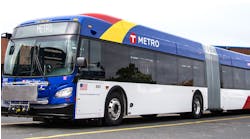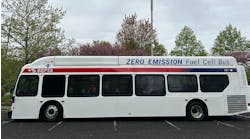At 3:18 p.m. April 8, the skies will go dark and Buffalo will come to a stop.
So will public transportation across Western New York.
The Niagara Frontier Transportation Authority said it will tell its drivers to stop their buses during the period that Western New York is in the path of totality during the solar eclipse.
Metro Bus passengers should expect buses to pull over to a safe spot, if traffic permits, said Sadie Kratt, the transportation planner for the NFTA. Operators and riders will be encouraged to get off the bus, use special safety glasses and experience the eclipse. Following the few minutes of totality, buses will be back on the road.
"Obviously there's a lot of unknowns with that ... whether or not they [operators] stick to it is sort of dependent on traffic," Kratt said.
Hundreds of thousands of people are expected to pour into Western New York for the once-in-a-lifetime event. Officials have begun warning people that gridlock on area roads is expected as people try to get to some of the most sought-after spots to witness the event.
"We are expecting delays just because of the amount of traffic so you can pretty much bank on your bus being late that day. So we're trying to encourage riders, if you don't have to go anywhere that day, try not to, but if you are, plan accordingly," Kratt said.
The NFTA oversees the Metro Bus and Rail, Buffalo Niagara International Airport and transit police departments in the Buffalo Niagara region.
On a regular weekday, the NFTA has up 60,000 riders on Metro Rail and Metro Buses, Kratt said.
The agency has procured 16,000 eclipse glasses with the help of Buffalo Science Museum for staff members, including operators and mechanics. Riders who use buses on April 8, will be able to get glasses on the bus so that they can safely look at the eclipse, Kratt added.
Riders also will receive email alerts about the bus schedule — whether it's slightly delayed or canceled — if they have signed up for the alerts. They can also check timings on apps such as Moovit and Transit, or on Google.
The NFTA has also set up a map listing key routes that will help riders access popular viewing spots via the transit system. The agency is planning "maximum service" on that day, Kratt said. The Route 77 and Route 40 buses that service Niagara Falls, Route 25 and Route 11 that go to Delaware Park, and Route 20 that goes to SUNY Buffalo State University are expected to be the busiest routes.
"We will stage a couple extra buses to add service, but we can't guarantee that right now just because it's going to be kind of a day-of thing," Kratt explained. "We're sort of treating it like an emergency event. So, unfortunately, a lot of unknowns, but we're running as much as we can."
According to experts, the eclipse begins at about 2:05 p.m., when the moon starts to partially occlude the sun. Full coverage starts in most of the region at 3:18. Total darkness — the only time to take off special shading glasses and gaze directly at the spectacle before a partial eclipse resumes — will linger longest at the centerline of the path of totality. The sun will then be partially covered until 4:32 p.m.
At the Buffalo Niagara International Airport, operations will run as usual, said Russel Stark, the airport's deputy director of aviation. During the eclipse when it gets dark, the airport will turn on all runway lights before turning them off when the sun comes out, Stark said.
Operators have been briefed about safe viewing practices, as will customers, he said. "Safety is paramount," Stark added. However, there will be no pauses in air services.
Mayor Byron W. Brown and members of the City's Eclipse Task Force are encouraging residents to prepare for delays, especially if they are trying to catch a flight that day.
"I think the biggest impact is going to be off the airport on the roadways," Brown said. "There's potential for increased road traffic. I ask our passengers to leave a little bit earlier to the airport to make sure they're on time and don't miss their flight."
___
(c)2024 The Buffalo News (Buffalo, N.Y.)
Visit The Buffalo News (Buffalo, N.Y.) at www.buffalonews.com
Distributed by Tribune Content Agency, LLC.

